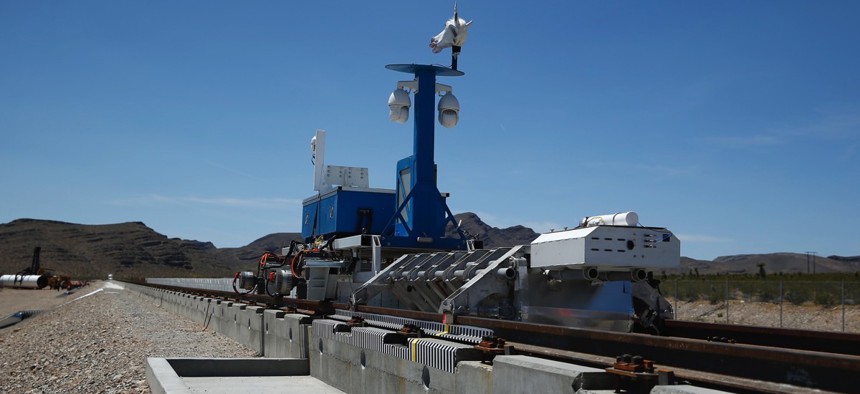Who Will Regulate Hyperloop?

A recovery vehicle and test sled sit on a track after a test of a Hyperloop One propulsion system on May 11, 2016, in North Las Vegas, Nevada. John Locher / AP Photo
Virgin Hyperloop One fancies itself a railroad, but the question is far from decided as the company nears the end of feasibility studies in several cities and states.
WASHINGTON — Exactly which federal agency hyperloop companies should work with on safety regulations is undecided, though frontrunner Virgin Hyperloop One has made early engagement with the Federal Railroad Administration and U.S. Department of Transportation a priority.
A hyperloop is a low-pressure, high-speed surface transportation system in which electromagnetic propulsion moves a vehicle suspended using magnetic levitation through a tube that eliminates aerodynamic drag. The technology is still in the testing phase, but proponents hope it will eventually become part of the transportation mix.
But the vehicle involved is more similar to a commercial aircraft than a train in terms of its aerodynamic structure, said Josh Raycroft, director of business strategy at Virgin Hyperloop One, during a Senate Commerce Committee hearing on Thursday.
Still, Virgin Hyperloop One wants hyperloops designated as railroads under federal law, which would make them eligible for certain federal formula money and discretionary grants like the Rural Innovation Fund program and Transportation Infrastructure Finance and Innovation Act credit assistance.
“We acknowledge that there are many aspects of our technology that might not fit neatly within that framework,” Raycroft said. “That said, we know the FRA has … moved more toward a system safety approach.”
Regulation by other DOT offices might also make sense, Raycroft added.
“We are going to have to be flexible with the different regulatory agencies that are out there and hopefully addressing the new, emerging technologies that still have a safety component,” said Sen. Catherine Cortez Masto, a Nevada Democrat.
Los Angeles-based Virgin Hyperloop One says it’s the leader in the space after achieving speeds of 240 mph at its test track in North Las Vegas, Nevada. The company is targeting speeds of 600 mph before it can become operational for passenger use in the mid-2020s, Raycroft said.
In the meantime, Virgin Hyperloop One is studying system feasibility with a number of state and local transportation agencies in Colorado, Ohio, Missouri and Dallas, Texas.
Colorado’s study of a hyperloop from Colorado Springs to Fort Collins, with a possible spur into the Rocky Mountains, should be completed in the fall. Dallas officials are eyeing hyperloop in combination with high-speed rail along a 30-mile corridor to Fort Worth, while the Regional Transportation Council there is considering extending the system to Laredo.
Virgin Hyperloop One wants its systems to be “modular,” Raycroft said.
“We can add in smaller stations as necessary, and they would have on-ramps to merge into the trunk line—very similar to what you see with highways today,” he said.
For instance, Missouri transportation officials have envisioned hyperloop travel to move people from Kansas City, Missouri to St. Louis in 30 minutes with an intermediate station in Columbia.
Hyperloops will not only allow people to live in less densely populated areas and access jobs, services and entertainment in metropolitan ones, but the technology has ramifications for cargo supply chains as well.
“More recently our transportation system has struggled to keep pace with the growing demands of a dynamic economy,” said Sen. John Thune, a South Dakota Republican. “Freight movement is expected to double over the next few decades.”
Congress has a chance with the upcoming reauthorization of the Fixing America’s Surface Transportation, or FAST, Act to help states and localities partner with private industry to deploy new mobility technologies, said Tina Quigley, general manager of the Regional Transportation Commission of Southern Nevada.
While the 2015 FAST Act establishing the Advanced Transportation and Congestion Management Technologies Deployment program was a “good start,” it’s “not sufficient,” Quigley said.
“Federal funding for private and public partnerships is essential,” she said. “We need to identify and support flexible policies that provide additional opportunities for pilots and testing new approaches.”
Her RTC hasn’t shied away from “unconventional partnerships” addressing traffic safety, congestion and capacity, Quigley added. She pointed to one alliance between all five cities in Southern Nevada, Clark County and the Nevada Department of Transportation establishing a “smart city” vision.
Lyft already offers non-Americans with Disabilities Act paratransit service in the region, and the RTC is in conversations with newcomer Tango Car to provide ride hailing to people with disabilities.
“Access for all” is Virgin Hyperloop One’s goal also, Raycroft said, likening hyperloop to “walking down the jet bridge to get on an aircraft.”
Quigley also asked senators for “unambiguous” infrastructure standards for emerging mobility tech like autonomous vehicles.
“There will be certain corridors that will be much more appropriate for autonomous vehicles than other corridors,” she said.
Raycroft couldn’t say how much an initial hyperloop system might cost by the mile but did say the company was taking first-mile, last-mile challenges into account and trying to make stations public transit accessible.
“We want to make sure that we’re connecting into existing infrastructure like transit,” he said. “We want to be intermodal in that way.”
Dave Nyczepir is a News Editor at Government Executive’s Route Fifty and is based in Washington, D.C.
NEXT STORY: Overcoming information governance inertia






